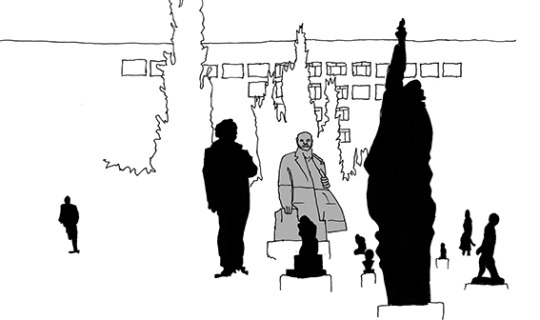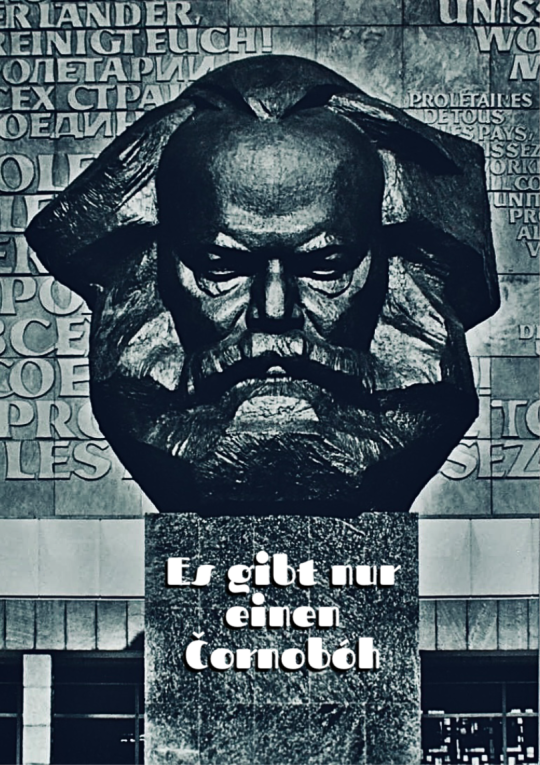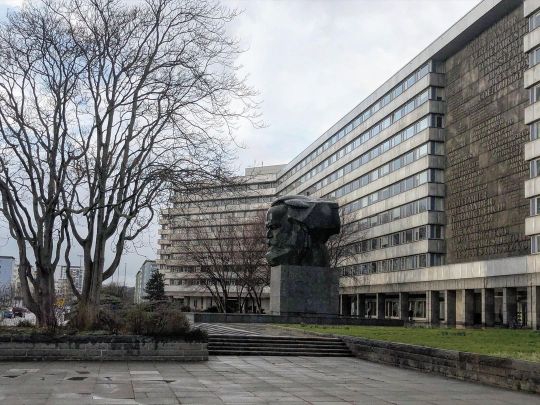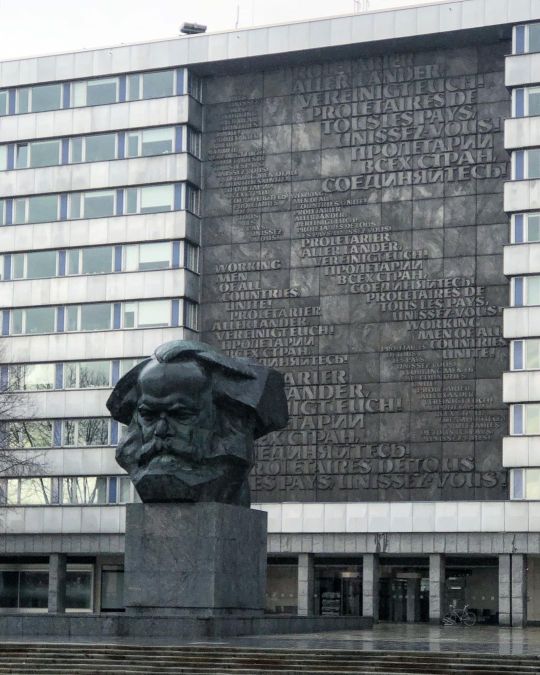#Lev Kerbel
Explore tagged Tumblr posts
Text

Lenin by Lev Kerbel, Museum of Socialist Art, Sofia. May 2023
I spent hours trying to find this museum. I asked 15 people on trams, tubes and walking. One person walked with me to show the way, another told me the wrong direction and one person asked for money after helping.
#lenin#sculpture#monument#steve faraday#ink drawing#urban sketch#illustration#on location#fineliner#usk#ink sketch#urbansketchers#sofia#bulgaria#art#Lev Kerbel#museum of socialist art
6 notes
·
View notes
Text

'Es gibt nur einen Čornobóh (There is only one black god)'
The impressive Karl Marx Monument illustrates very well Karl Marx as a counterpart to any politically right-wing or reactionary role model. The black appearance of the monument in the photo is the analogy to the black god in autochthonous Sorbian mythology. There is only one God who can stand up against the tendency to erase Sorbian history in the original settlement area. In my opinion, the bust of Karl Marx by Lev Kerbel is the optimal representation of a black god.
Čornobóh / Schwarzer Gott / Black God
Black God series, 2021
#czorneboh#bismarck#bautzen#karl marx#Das Kapital#Chemnitz#karl marx stadt#nsk#nskstate#nsk folk art#nsklipsk#black GOD#Neue Sorbische Kunst#Schwarzer Gott#Black God#Cornoboh#Lev Kerbel
2 notes
·
View notes
Photo

Russian sculptor Lev Kerbel next to a giant model for a monument to Karl Marx.
16 notes
·
View notes
Photo

In the studio of sculptor Lev Kerbel. Photo by Viktor Akhlomov (USSR, 1962)
160 notes
·
View notes
Photo

: . The monument of Karl Marx by Lev Kerbel, erected in 1969, image by Stefan Rusu . Haus der Statsorgane und Haus der Partei, designed by Gunter Schliegel, Wolfgang Seidel, Gunter Arnold, built in 1968-70, 1977-79 . . #karlmatxstadt #karlmarx #workshop #urbanism #industruallandscape . #insularmodernities #socialistcityandurbanism . #publicspaces_chemnitz #stefanrusuprojects #publicspace #urbanism_chemnitz #socialistarchitecture_eastgermany #eastgermanmodernism #modernismtour_eastgermany #socialistarchitecture #modernismtour_chemnitz #socialistcity_chemnitz #socialistcity #postsovietcity #chemnitz #chemnitzcity . ©insularmodernities . https://www.instagram.com/p/B_iXUEnplab/?igshid=NGJjMDIxMWI=
#karlmatxstadt#karlmarx#workshop#urbanism#industruallandscape#insularmodernities#socialistcityandurbanism#publicspaces_chemnitz#stefanrusuprojects#publicspace#urbanism_chemnitz#socialistarchitecture_eastgermany#eastgermanmodernism#modernismtour_eastgermany#socialistarchitecture#modernismtour_chemnitz#socialistcity_chemnitz#socialistcity#postsovietcity#chemnitz#chemnitzcity
10 notes
·
View notes
Photo


Now on Propagandaworld.org Bronze statue of Karl Marx. In very good condition. Size: 15x8cm./5.9×3.1inch. The inscription on the front says:”Proletarian Of All Nations Unite!”. The real statue stands in Moscow on the revolution Square and is made by Lev Kerbel. Lev Efimovich Kerbel (1917-2003) was a sculptor of Soviet realist works. Kerbel’s creations included statues of Marx, Lenin, Yuri Gagarin, which were sent by Soviet Government as gifts to socialist and the Third World countries across the world. In the 1990s following the collapse of the socialist bloc many of his works of art were destroyed. However his enormous Karl Marx monument in Chemnitz, formerly Karl-Marx-Stadt, has been preserved as a cultural monument. Kerbel was born to a Russian Jewish family in the village of Semyonovka in Russia (currently Ukraine) on the day that the Winter Palace in Petrograd was stormed by the Bolsheviks setting off the October Revolution. During World War II, Kerbel helped build the defenses for the Battle of Moscow, then served in the Northern Fleet. After the war, Kerbel’s career took off with a wide range of commissions. In 1958 he sculpted a statue in China that depicted a huge Soviet and an equally large Chinese worker hand in hand. When Soviet-Chinese relations foundered a few years later, the statue was torn down by a mob. While some people dismiss Kerbel’s works as a form of flat Communist propaganda, Kerbel himself said that he was always more interested in art than politics. Many people now view his few remaining statues with nostalgia, particularly in Chemnitz (formerly known as Karl Marx Stadt, where his bust of Karl Marx is referred to as ‘the head’. One of Kerbel’s last works was the memorial to the crew of the Kursk submarine, inaugurated in Moscow in 2003.
2 notes
·
View notes
Photo

“KARL MARX in GRANITE” A 1961 sculpture by Lev Kerbel located in Theater Square in Moscow. Sketched from an Ivan Silantyev photo, so it’s a Virtual Sketchwalk. Another in the Moscow series. Sketched quickly with a CROSS Bailey fountain pen with PLATINUM Carbon ink and watercolor shading applied with a PRINCETON brush in a SM*LT watercolor sketchbook. #LobstArtstudios @tom.Brudzinski #dessinateur #artist #dessin #sketch #drawing #quicksketch #RanDOODLINGdom #croquisrapide #croquis #szkic #crossbailey #crossbaileyfountainpen #platinumcarbon #platinumcarbonink #pandemicsketching #virtualsketchwalk #blacksndwhite #smlt #moscow #moscowsculpture #karlmarx @ivansilantyev (at Moscow, Russia) https://www.instagram.com/p/CNZgjbinyoA/?igshid=3x4h51c270a7
#lobstartstudios#dessinateur#artist#dessin#sketch#drawing#quicksketch#randoodlingdom#croquisrapide#croquis#szkic#crossbailey#crossbaileyfountainpen#platinumcarbon#platinumcarbonink#pandemicsketching#virtualsketchwalk#blacksndwhite#smlt#moscow#moscowsculpture#karlmarx
0 notes
Text
Concrete Patterns
Text and photo by © Roberto Conte
In my never-ending hunt for interesting and not very well-known architecture, a very important part is devoted to the buildings featuring the magical word pattern. In the lack of traditional decorations typical of the modernist buildings, and more in general of what was built after the Second World War, the geometrical schemes of many facades becomes often one of the most recognizable features of architectures, sometimes with slight hypnotic effects.

The first building of this selection is the Cosmos Hotel by B. Banykin and I. Kolbayeva (1983) in Chișinău, capital of the Republic of Moldova, a country once part of the Soviet Union and therefore a destination for a lot of Russian tourists. Not used anymore as much as in the past, it is located in front of a central roundabout of the city. Even if literally surrounded by recent shopping malls, it is still standing showing the dynamic series of its modern balconies as background of the much more traditional horse statue of Grigory Kotovsky, an important and controversial local Soviet figure.
Starting from the name of the hotel itself, the building has an overall cosmic look, very influenced by the Space Race of the Cold War that inspired so many other architects all over the former Soviet Republics. In his book Cosmic Communist Constructions Photographed by Frédéric Chaubin are documented other subversive Soviet superstructures.

In the Russian city Samara, 1,700 km deeper in the former Soviet Union, we find another stunning architecture whose exterior is shaped and articulated by the intersections of concrete elements. A project by the architect Alexander Belokon with a very brutalist outlook, built when the city was still called Kuybyshev (dedicated to a Bolshevik revolutionary, the previous name of Samara was used again after 1991).
In this 20-storey residential high rise, the asymmetrical balconies are alternatively connected one to another creating a strong and rather impressive effect, that is highlighted by the position of the building itself on a big avenue and without other buildings around covering the sight. A similar solution was used also for the security staircases on the short sides.

Outside the former Soviet world, in Créteil (a town just outside Paris) stands another example of balconies shaping up in a very curious way the external parts of architectures, in this case with a kind of biological rhythm.
The Choux de Créteil is a large complex listed as heritage of the 20th century by the French Ministry of Culture and made by several 15-storey towers. The architect, Gérard Grandval, originally wanted the balconies to be totally covered with plants and vegetations, something probably similar to the recent Vertical Gardens by Stefano Boeri in Milan but made much stronger by the vegetal and curved concrete shape of the French buildings. That would have given these towers a very different look, but the first developers refused this idea to avoid insects and thinking that the residents would have not care of the plants enough.

City Hall Chemnitz was built in the former German Democratic Republic, when the city had the eloquently socialist name of Karl-Marx-Stadt. Moreover, a famous gigantic statue of Marx (the second largest bust in the world) realized by the Russian sculptor Lev Kerbel is still standing very near the fascinating city hall. In the building the geometry of the architecture is not made up by balconies, but it is covered with very peculiar polygonal concrete precast elements put one upon the other, like tiles, making the external look of this architecture much more vigorous.

A similar solution was used in another building just behind the hectic Oxford Street, located in the very center of London. In fact, even the facade of the Welbeck Street car park, built few years before the city hall in Chemnitz, is totally covered by precast concrete structures. The original shape of a sci-fi diamond is shaping also the corners of the building. The car park was recently denied to be listed as public heritage by the government body Historic England and after that put on sale by the previous owner. According to news of early 2016 it may be demolished to leave space for a brand new hotel.

__

Roberto Conte (1980) is based in Monza, Italy. He is exploring abandoned places in Italy and abroad since 2006. He’s focus are architectures of the XX century, particular brutalism and socialist modernism. He collaborates with the Architecture Academy of Mendrisio, Switzerland and architecture studios. Published in magazines like Domus, ArchDaily, Designboom, Divisare, La Repubblica and books as "This Brutal World" Phaidon Press and "Concrete Concept" Frances Lincoln. During his exploration of Russia in 2016, he exhibited a series of pictures about brutalist architecture in the Contemporary Art Department in Togliatti, and attended a collective art exhibition in an abandoned industry in Barreiro, Lisbon in 2015. Conte won the II Eurostars Berlin Photography Competition in 2015. Follow his Facebook and Instagram.
5 notes
·
View notes
Text
"Nischelgasse" (Das Karl-Marx-Monument) Chemnitz, Germany. unveiled in 1971 scul...
“Nischelgasse” (Das Karl-Marx-Monument) Chemnitz, Germany. unveiled in 1971 scul…
[ad_1]
“Nischelgasse” (Das Karl-Marx-Monument) Chemnitz, Germany. unveiled in 1971 sculptor Lev Kerbel © B.A.C.U. @_BA_CU #_BA_CU . . Add new sites: http://socialistmodernism.com/add-locations-visitors/ . . Map location: http://socialistmodernism.com/ . . Use the #SocialistModernism #socmonumentalart tag and your #SocHeritage shots will enter our selection and possibly be featured in our…
View On WordPress
#_BA_CU#chemnitz#germany#monument#nischelgasse#SocHeritage#SocialistModernism#socmonumentalart#unveiled
0 notes
Photo

Soviet-Jewish sculptor Lev Kerbel (1917 - 2003) with fellow Soviet sculptor Vladimir Tsigal (1917 - 2013), 1945
Kerbel is known for several works, among them the Karl Marx bust in Chemnitz, Germany, and the Lenin monument in Havana, Cuba. Tsigal served as a military artist in the navy and later created the monument to D.M. Karbyshev at the site of the former Mauthausen concentration camp. The two created several monuments to the Red Army together in the post-war period.
131 notes
·
View notes
Photo

Yevgeny Khaldei - Marx and sculptor Lev Kerbel, Moscow, 1970 [***]
164 notes
·
View notes
Photo

: . man walks through the square next to Stadthalle, in the background the giant portrait of Karl Marx and former Haus der Statsorgane und Haus der Partei . The monument of Karl Marx by Lev Kerbel, erected in 1969 . Haus der Statsorgane und Haus der Partei, designed by Gunter Schliegel, Wolfgang Seidel, Gunter Arnold, built in 1968-70, 1977-79 . #insularmodernities #nationalmodernism #decolonisingmodernity #socialistarchitecture_chemnitz #socialistarchitecture #socialistarchitecture_eastgermany #socialistarchitecture #socialistcity_chemnitz #socialistcityandurbanism #chemnitz #eastgermany #archdaily #dezeen #sovmod #sovarch #sovietarchitecture #соварх #совмод #архитектура #модернизм #соцарх #соцархитектура #socialist #socialistcity . ©insularmodernities . (at Chemnitz, Germany) https://www.instagram.com/p/B9RxLyNJbhB/?utm_medium=tumblr
#insularmodernities#nationalmodernism#decolonisingmodernity#socialistarchitecture_chemnitz#socialistarchitecture#socialistarchitecture_eastgermany#socialistcity_chemnitz#socialistcityandurbanism#chemnitz#eastgermany#archdaily#dezeen#sovmod#sovarch#sovietarchitecture#соварх#совмод#архитектура#модернизм#соцарх#соцархитектура#socialist#socialistcity
14 notes
·
View notes
Photo

: . The monument of Karl Marx by Lev Kerbel, erected in 1969. . Behind the monument is Haus der Statsorgane und Haus der Partei, designed by Gunter Schliegel, Wolfgang Seidel, Gunter Arnold, built in 1968-70, 1977-79 . . #insularmodernities #nationalmodernism #decolonisingmodernity #socialistarchitecture_eastgermany #postsovietcity #postsovietcontext #modernismtour_eastgermany #modernismtour_chemnitz #chemnitzcity #chemnitz #socialistcity_chemnitz #socialistcity #chemnitz #eastgermany #eastgermanmodernism . ©stefanrusu . (at Chemnitz, Germany) https://www.instagram.com/p/B_iSg5Ppo7d/?igshid=1n9jltjpmbnuo
#insularmodernities#nationalmodernism#decolonisingmodernity#socialistarchitecture_eastgermany#postsovietcity#postsovietcontext#modernismtour_eastgermany#modernismtour_chemnitz#chemnitzcity#chemnitz#socialistcity_chemnitz#socialistcity#eastgermany#eastgermanmodernism
3 notes
·
View notes
Photo

: . The monument of Karl Marx by Lev Kerbel, erected in 1969. Image by Stefan Rusu . Haus der Statsorgane und Haus der Partei, designed by Gunter Schliegel, Wolfgang Seidel, Gunter Arnold, built in 1968-70, 1977-79 . #insularmodernities #nationalmodernism #decolonisingmodernity #socialistarchitecture_chemnitz #socialistarchitecture #socialistarchitecture_eastgermany #socialistarchitecture #socialistcity_chemnitz #socialistcityandurbanism #chemnitz #eastgermany #archdaily #dezeen #sovmod #sovarch #sovietarchitecture #соварх #совмод #архитектура #модернизм #соцарх #соцархитектура #socialist #socialistcity . ©insularmodernities . (at Chemnitz, Germany) https://www.instagram.com/p/CBEKTVGJ_IX/?utm_medium=tumblr
#insularmodernities#nationalmodernism#decolonisingmodernity#socialistarchitecture_chemnitz#socialistarchitecture#socialistarchitecture_eastgermany#socialistcity_chemnitz#socialistcityandurbanism#chemnitz#eastgermany#archdaily#dezeen#sovmod#sovarch#sovietarchitecture#соварх#совмод#архитектура#модернизм#соцарх#соцархитектура#socialist#socialistcity
18 notes
·
View notes
Photo

:
.
The monument of Karl Marx by Lev Kerbel, 1969
.
Haus der Statsorgane und Haus der Partei, designed by Gunter Schliegel, Wolfgang Seidel, Gunter Arnold, built in 1968-70, 1977-79
.
.
#karlmatxstadt #karlmarx #workshop #urbanism #industruallandscape
.
#insularmodernities
#socialistcityandurbanism
.
#publicspaces_chemnitz
#stefanrusuprojects
#publicspace
#urbanism_chisinau #socialistarchitecture_eastgermany #eastgermanmodernism #modernismtour_eastgermany #socialistarchitecture
#modernismtour_chemnitz
#socialistcity_chemnitz
#socialistcity
#postsovietcity
#chemnitz #chemnitzcity
.
©insularmodernities
.
https://www.instagram.com/p/CHqWg50Mgv7/?igshid=qvopuyr4nswm
#karlmatxstadt#karlmarx#workshop#urbanism#industruallandscape#insularmodernities#socialistcityandurbanism#publicspaces_chemnitz#stefanrusuprojects#publicspace#urbanism_chisinau#socialistarchitecture_eastgermany#eastgermanmodernism#modernismtour_eastgermany#socialistarchitecture#modernismtour_chemnitz#socialistcity_chemnitz#socialistcity#postsovietcity#chemnitz#chemnitzcity
15 notes
·
View notes
Photo

: . The monument of Karl Marx by Lev Kerbel, erected in 1969. Image by Stefan Rusu . Haus der Statsorgane und Haus der Partei, designed by Gunter Schliegel, Wolfgang Seidel, Gunter Arnold, built in 1968-70, 1977-79 . #insularmodernities #nationalmodernism #decolonisingmodernity #socialistarchitecture_chemnitz #socialistarchitecture #socialistarchitecture_eastgermany #socialistarchitecture #socialistcity_chemnitz #socialistcityandurbanism #chemnitz #eastgermany #archdaily #dezeen #sovmod #sovarch #sovietarchitecture #соварх #совмод #архитектура #модернизм #соцарх #соцархитектура #socialist #socialistcity . ©insularmodernities . (at Chemnitz, Germany) https://www.instagram.com/p/CBEKTVGJ_IX/?igshid=hvx6w5i2n1xz
#insularmodernities#nationalmodernism#decolonisingmodernity#socialistarchitecture_chemnitz#socialistarchitecture#socialistarchitecture_eastgermany#socialistcity_chemnitz#socialistcityandurbanism#chemnitz#eastgermany#archdaily#dezeen#sovmod#sovarch#sovietarchitecture#соварх#совмод#архитектура#модернизм#соцарх#соцархитектура#socialist#socialistcity
10 notes
·
View notes